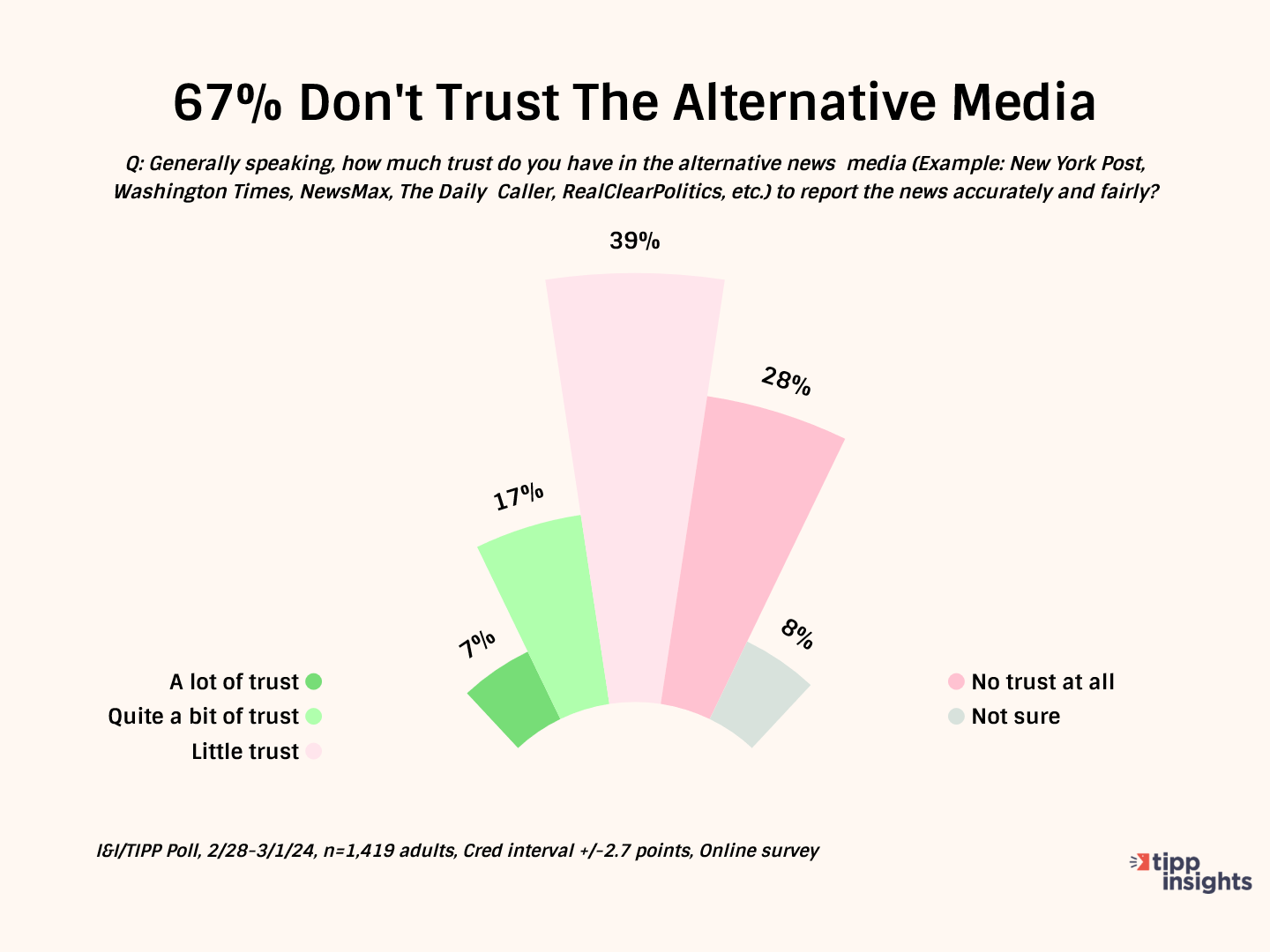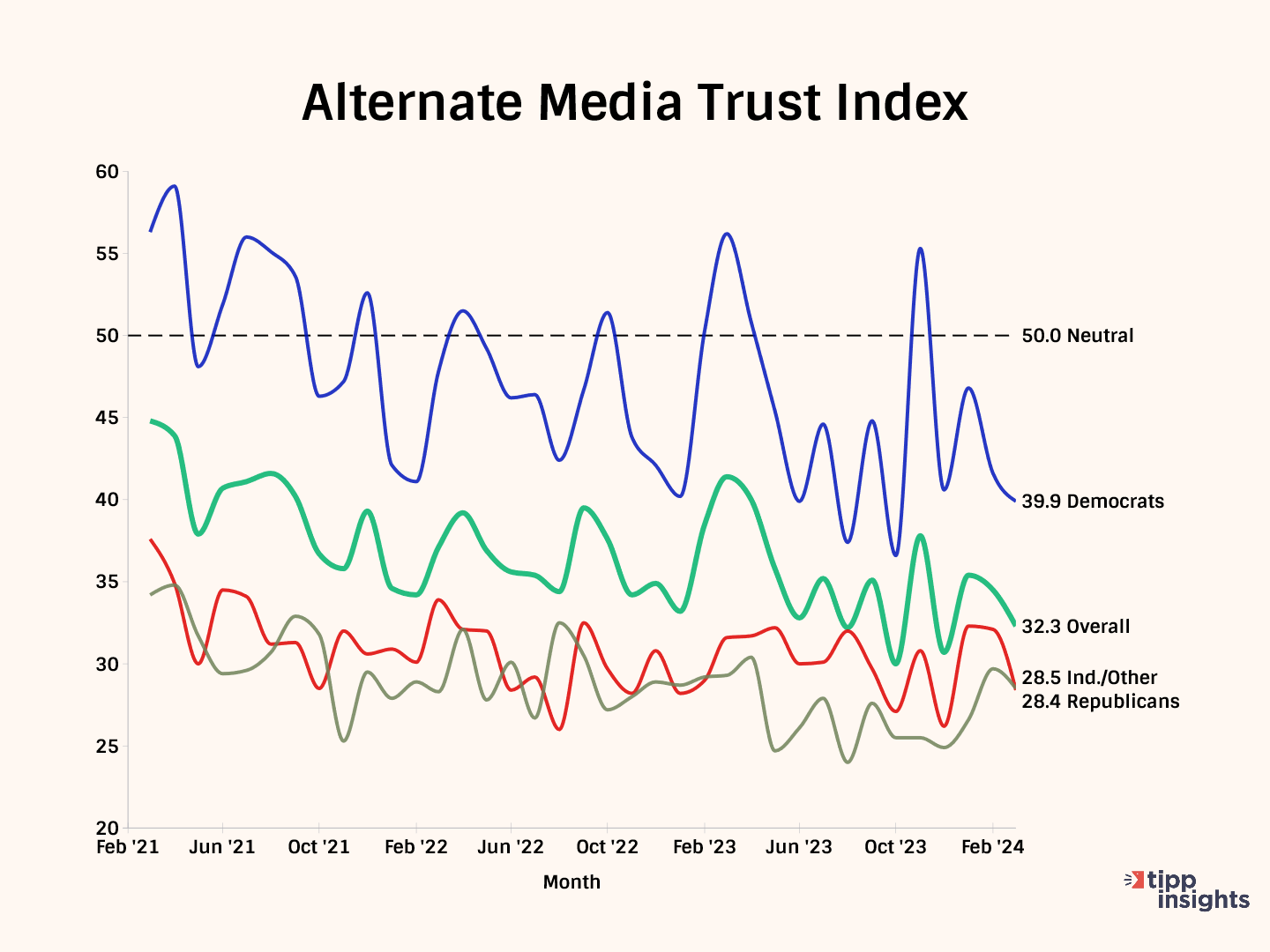Can the U.S. media ever reverse their reputation for dishonesty and bias and end their current tailspin? Given how the public currently views them, the answer is “not likely,” the latest I&I/TIPP Poll suggests.
Each month I&I/TIPP Poll asks registered voters from around the country to gauge their trust in the major media that supply them with news, features and other information.
Specifically, two questions were asked:
“Generally speaking, how much trust do you have in the traditional or established news media (Example: Washington Post, New York Times, NPR, CBS News, etc.) to report the news accurately and fairly?”
And, “Generally speaking, how much trust do you have in the alternative news media (Example: New York Post, Washington Times, NewsMax, The Daily Caller, RealClearPolitics, etc.) to report the news accurately and fairly?”
Responses to the first question make up the “Traditional Media Trust Index,” while answers to the second are included in the “Alternate Media Trust Index”; 1,419 Americans responded to the national online poll, which was taken from Feb. 28-March 1. The poll has a margin of error of +/-2.7 percentage points.
How well are the media doing their job of informing Americans? Not very, voters overwhelmingly say. In fact, only one-third (34%) trust traditional media, and six in ten (61%) don’t. A third (32%) say they have “little trust,” and another 29% have “no trust at all.”


The Traditional Media Index fell in March and now stands only slightly above its all-time lows in October.
The Traditional Media Index fell 4.8%, from 39.9 to 38. This index includes such big media outlets as The Washington Post, The New York Times, NPR, and CBS News. The March reading is above October’s record low of 35.8, but well below the all-time average of 41.3 and the all-time high of 51.
Looking at how various demographic and political groups view the media, a somewhat different picture emerges, with Democrats and minorities somewhat higher in trust, while Republicans and whites are much lower.
For instance, Democrats give the traditional media outlets high marks, 56.1 (still down 5.2% from February), compared to an abysmal 23.7 (down 6.3%) from Republicans and 33.2 (off 3.4%) for independents and members of third parties.
Another big gap is how the major media are perceived by race.
Among white Americans, trust in the big mainstream media stands at just 34.2 in March, up 2% from February. For blacks and hispanics, it’s 10 points higher at 44.2, down 11.8% and the lowest since the low set in October of last year.
But the non-traditional media, including The New York Post, The Washington Times, NewsMax, The Daily Caller, and Real Clear Politics, among others, performed even worse. In fact, only one-fourth (24%) trust alternate media, and two-thirds (67%) don’t. A whopping (39%) say they have “little trust,” and another 28% have “no trust at all.”


The alternative media index dropped 6.4% from 34.5 to 32.3. That too is above the nadir of 33.0 in October, but below the 36.8 all-time average and the 44.8 record high.
For alternative media, Democrats’ trust reading stood at 39.9 in March, off 4.1%. Republicans’ trust index reading dropped 11.5% to 28.4, while independents declined 4% to 28.5.
The race gap shows up for the alternative media as well. For whites, the drop was 5.6% to 28.2, while the index for blacks and hispanics it dropped 9.8% to 38.1.
What does this all mean? That the media, broadly defined, seem to be in big trouble with the very people that once kept them in business.
It’s widely acknowledged that Americans perceive the media as politically biased in favor of liberal/left beliefs, as poll after poll indicate. This is likely the big reason why Democrats give higher marks to all media than do Republicans and independents.
It shows the wide, and possibly growing, cultural and political gap between the center-right America (Republicans and independents) and the left (Democrats).
A recent Gallup Poll indicated that 28% of Americans identified as Republican, while 30% identified as Democrat. Independents, third-party followers and others, meanwhile, accounted for 42% of the electing population.
So over two-thirds of the population now mostly identifies as center-right in political orientation, while less than a third identify as liberal-left. (Of course, some Republicans have fairly liberal beliefs, while some Democrats remain centrist).
Still it goes a long way toward explaining the media’s continued shrinkage and its collapsing readership. Since 1990, according to Pew Research data, daily circulation of newspapers has plunged from roughly 63 million to just over 20 million in 2022. Digital circulation, however, is flat, with the grand exception of the Wall Street Journal and the New York Times.
Perhaps more importantly, as of 2022, total circulation and ad revenues stood at roughly $21.4 billion, down sharply from $59.8 billion as recently as 2006. So the news business contracted by two-thirds in just 16 years.
What has happened? The media industry, once dominated by giants that at least pretended to be objective and fair, has become Balkanized, with smaller, more specialized online competitors and websites taking away eyes and dollars from the once all-powerful big media corporations.
This isn’t just conjecture. The media outlets themselves lament their current fallen state, and appear clueless as to the cause.
As the New York Times wrote in January, “Mass layoffs, closures and reader fatigue are afflicting news organizations as Americans prepare for a consequential election year.”
Meanwhile, “The Shrinking Newsroom Crisis Will Be Impossible To Ignore,” shrieks a recent Time headline.
None of these, unfortunately, ask the question: Why do Americans no longer trust us? Why do they perceive us as deeply biased, in particular toward left-wing ideas? The fact is, many Americans are looking for alternatives to the big media and their steady leftward drift.
As the American Council on Science and Health recently opined, “Reporters like to portray themselves as truth tellers who hold the powerful accountable. In reality, many of them are hired guns who publish propaganda under the guise of doing journalism. The good news is that a growing number of Americans are abandoning the legacy media for better sources of information.“
Until the media understand why 70% of Americans think they’re doing a poor job and come to grips with their own clear biases, it’s likely their decline will continue.
I&I/TIPP publishes timely, unique, and informative data each month on topics of public interest. TIPP’s reputation for polling excellence comes from being the most accurate pollster for the past five presidential elections.
Terry Jones is an editor of Issues & Insights. His four decades of journalism experience include serving as national issues editor, economics editor, and editorial page editor for Investor’s Business Daily.
Our performance in 2020 for accuracy as rated by Washington Post:









